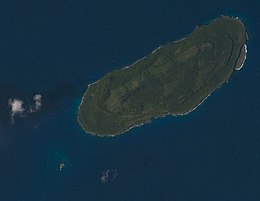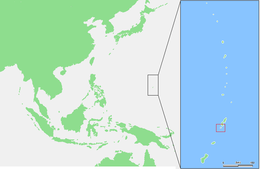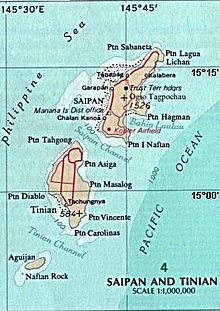Aguiguan (original) (raw)
From Wikipedia, the free encyclopedia
Island in the Northern Marianas island chain
Aguijan
 Satellite view, with Naftan Rock visible to the southwest Satellite view, with Naftan Rock visible to the southwest |
|
|---|---|
 |
|
| Geography | |
| Location | Pacific Ocean |
| Coordinates | 14°51′13″N 145°33′34″E / 14.85361°N 145.55944°E / 14.85361; 145.55944 |
| Archipelago | Northern Mariana Islands |
| Area | 7.01 km2 (2.71 sq mi)[1] |
| Length | 4.7 km (2.92 mi) |
| Width | 1.8 km (1.12 mi) |
| Highest elevation | 157 m (515 ft) |
| Administration | |
| United States | |
| Commonwealth | Northern Mariana Islands |
| Demographics | |
| Population | 25 (2022) |
Aguijan (/æɡɪˈjɑn/; Spanish: Aguiján [aɡiˈxan]; also Aguiguan and Aguihan, based on the Spanish rendition of the native name) is a small bean-shaped uninhabited coralline island in the Northern Mariana Islands chain in the Pacific Ocean. It is situated 8 kilometers (5.0 mi) south-west of Tinian, from which it is separated by the Tinian Channel. Aguijan and neighboring Tinian Island together form Tinian Municipality, one of the four main political divisions that comprise the Northern Marianas. The island is inhabited by wild goats and the last known habitat of a rare Pacific bat, as well as many species of birds. During WW2 a Japanese garrison was on the island, which surrendered at the end of the War without a battle. Access to the island is inhibited by the lack of a natural harbor.
Aguigan, viewed from the southern end of Tinian
It is likely that first sighting by Europeans occurred during the Spanish expedition of Ferdinand Magellan, or by its continuation by Gonzalo Gómez de Espinosa being charted as Santo Ángel. It was visited by the Spanish missionary Diego Luis de San Vitores in 1669.[2]
In the mid-19th century it was known that goats were introduced to the island.[3] In the 1930s there was an attempt to grow sugar cane here, and areas were cleared for this purpose.[3]
Aguijan was administered as part of the Spanish Mariana Islands from the 16th century to 1899, when the Northern Marianas were sold by Spain to the German Empire. Under Germany, it was administered as part of German New Guinea. During World War I, Aguijan came under the control of the Empire of Japan and was administered as part of the South Seas Mandate. During World War II, the Imperial Japanese Army maintained a garrison on Aguijan. This garrison is noteworthy because of its surrender to Allied forces September 4, 1945, two days after the surrender of Japan. The surrender was unique as it was the only surrender hosted by a U.S. Coast Guard Cutter, the USCG 83525. US Navy Admiral Marshall R. Greer received the surrender of the Japanese Second Lieutenant Kinichi Yamada.[4]
Following World War II, Aguijan came under the control of the United States and was administered as part of the Trust Territory of the Pacific Islands. Since 1978, the island has been part of the Commonwealth of the Northern Mariana Islands, which along with the rest of the CNMI became part of the United States in the late 20th century.
In modern times the island is called Aguijan Island or Aguiguan, or it also goes by Goat island.[5][6] It is known for its population of feral goats, but is also the last known habitat for the Pacific sheath-tailed bat (Emballonura semicaudata rotensis).[6] It's currently known to have over 1000 feral goats which have inhabited the island for around two centuries.[3] Additionally, the island is home to many species of birds.[3]
Aguijan is separated from Tinian by Tinian Channel (1988 map)
Map of soil types on the islands of Tinian and Aguijan
Aguijan is only 7.09 square kilometers (2.74 sq mi) in size, with a length of 4.7 km (2.9 mi) and a width of 1.8 km (1.1 mi).[5] The island is a mix of forests and fields, and home to many species native to the Marianas, especially some rare bird species.[3]
The island has an area of about 7.3 km2 and is uninhabited but visited periodically.[5] Due to its sheer steep cliffs, the island has no natural harbor, bay, or beaches, therefore making it difficult for boats to land on.[3] However, a 2002 survey of the island found a handful of native species there, including the Mariana fruit bat, the Polynesian sheath-tailed bat and the Micronesian megapode Megapodius laperouse.
The Tastumi fishing bank is also in this area.[5]
Map including Naftan Rock
Approximately 1 kilometer (0.62 mi) off the south-west shore of Aguijan is Naftan Rock, 18 meters (59 ft) in elevation.[7]
Important Bird Area
[edit]
Aguijan and Naftan Rock have been recognised as an Important Bird Area (IBA) by BirdLife International because they support populations of Micronesian megapodes, white-throated ground doves, Mariana fruit doves, Mariana swiftlets, Micronesian myzomelas, rufous fantails, Aguijan reed warblers, golden and Saipan white-eyes, and Micronesian starlings. Aguijan also supports seabird breeding colonies, with 120 pairs of brown boobies and 450 pairs of brown noddies reported, while Naftan Rock is home to several thousand seabirds.[8]
- Tinian Naval Base
- Russell E. Brainard et al.: Coral reef ecosystem monitoring report of the Mariana Archipelago: 2003–2007, NOAA Fisheries, Pacific Islands Fisheries Science Center (2012).
- ^ "6 AGUIJAN" (PDF). National Oceanic and Atmospheric Administration. p. 1. Archived (PDF) from the original on 15 November 2020. Retrieved 15 November 2020.
- ^ Burney, James (1817). "3 – Voyage round the World, by Commodore George Anson". A Chronological History of the Discoveries in the South Sea Or Pacific Ocean. Vol. 5. London: Luke Hansard & Sons. p. 57.
- ^ a b c d e f Amidon, Fred; Camp, Richard J.; Marshall, Ann P.; Pratt, Thane K.; Williams, Laura; Radley, Paul; Cruz, Justine B. (December 2014). "Terrestrial bird population trends on Aguijan (Goat Island), Mariana Islands". Bird Conservation International. 24 (4): 505–517. Bibcode:2014BirCI..24..505A. doi:10.1017/S0959270914000021. ISSN 0959-2709.
- ^ USCG Historian’s Office (September 4, 2009). "This Day in Coast Guard History – Sept. 4". MarineLink. Archived from the original on December 7, 2023. Retrieved October 11, 2023.
- ^ a b c d "Tinian Island (& Aguijan island, Tatsumi bank) – Pacific Islands Benthic Habitat Mapping Center". Pacific Islands Benthic Habitat Mapping Center. University of Hawaiʻi at Mānoa. Archived from the original on October 21, 2023. Retrieved October 11, 2023.
- ^ a b Fort Collins Science Center (December 15, 2016). "Aguiguan (aka Goat Island), Northern Mariana Islands". United States Geological Survey. Archived from the original on September 18, 2023. Retrieved October 11, 2023.
- ^ "Aguijan Optical Validation - NOAA Nautical Chart #8 1067". University of Hawaiʻi. National Oceanic and Atmospheric Administration. Archived from the original on February 15, 2021. Retrieved October 20, 2018.
- ^ "Aguiguan Island and Naftan Rock". BirdLife Data Zone. BirdLife International. 2021. Archived from the original on September 18, 2023. Retrieved February 8, 2021.
Wikimedia Commons has media related to Aguijan.
- U.S. Coast Guard Historian's Office, Daily Chronology of Coast Guard History (Entry for 4 September)
- archive
- Pascal Horst Lehne and Christoph Gäbler: Über die Marianen. Lehne-Verlag, Wohldorf in Germany 1972. and Aguijan
- Google: Aguijan
From the website https://web.archive.org/web/20110728145947/http://www.uscg83footers.org/new_page_8.htm - Vessel corrected to be the Coast Guard Cutter 83525 Researched by Larry Richter, USCG Ret




